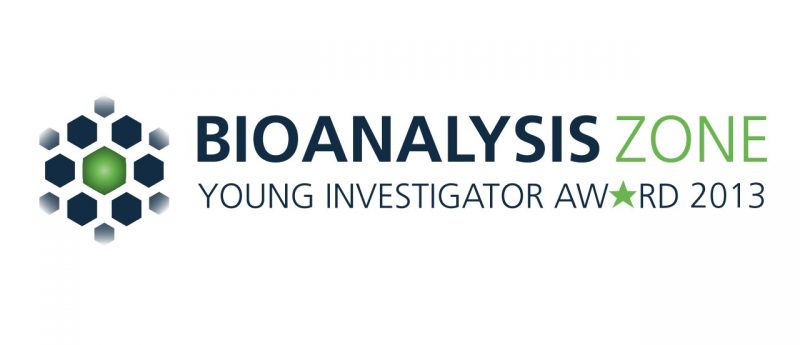2013 Young Investigator Award Finalist: Wanlong Zhou

Nominee:
Nominated By:
Supporting Comments:
What drove you to choose a career in bioanalysis?
I have been motivated by the complexity and the fast development of bioanalytical techniques and would like to pursue a research career related to public health and environmental protection. I took the opportunity to work at the US FDA Center for Food Safety and Applied Nutrition because the research projects were of great interest to me. For example, one exciting project I was involved in was to assess the penetration of topically applied peptides, used in consumer cosmetic products, for in vitro skin penetration studies, for purposes of evaluating the safety of consumer cosmetic products containing these peptides. I have been fortunate to work in a research group directed in protecting the public health.
Describe the main highlights of your bioanalytical research, and its importance to the bioanalytical community both now and in the future.
Development of rapid analytical methods for in vitro skin penetration studies of peptides is challenging because of the need for high sensitivity and accurate quantification of peptides in complex skin samples and vehicle matrices. To date, only a few HPLC–UV methods have been reported for the analysis of peptides for skin penetration studies. I developed and fully validated the first hydrophilic interaction LC–MS/MS (HILIC) method for the analysis of the peptides, Ac-EEMQRR-amide and H2N-EEMQRR-amide. This method was then used for the determination of these peptides in various complex matrices, including emulsion, receptor fluids, cotton tipped applicators, stratum corneum tape strips, epidermis, and dermis of the skin. A HILIC-SPE procedure was developed to minimize significant ion suppression that would affect quantification in the more complex sample matrices. In addition, stable isotopically labeled peptides, corresponding to the above native peptides, were used to compensate for these matrix effects. To the best of our knowledge, this was the first method that used HILIC–MS/MS, HILIC SPE in combination with stable isotopically labeled standards to overcome matrix effects and provide accurate quantification in these complex sample matrices. The first phase of study has been published in J. Chromatography A [Publication No. 4]. The second and third manuscripts are under review (Bioanalysis) and under preparation.
Describe the most difficult challenge you have encountered in the laboratory and how you overcame it?
The most difficult challenge is composed of two parts. One part is that the peptides are very polar and exhibit poor retention on reversed phase columns. Although the polar peptides could be retained on a HILIC (amide) column, one peptide had serious tailing and resulted poor sensitivity. By optimizing the composition of mobile phases, a symmetric peak was obtained and sensitivity was significantly increased. The serious carryover was observed for the peptides, which influenced LLOQ and accuracy for the low end points of the calibration curve. A priming procedure was developed to reduce carryover. In addition, the composition of weak needle and strong needle wash solution were optimized to future minimize the carryover. Sample clean-up for epidermis, dermis of the skin, and receptor fluid with low concentrations of peptides is the second major challenge. Common clean-up SPE methods such as reversed phase cartridges, ion-exchange cartridges, size-exclusion cartridges, dialysis tube and even mixed-mechanism cartridges have been attempted for this study, but none of the above was promising. After numerous tests, a HILIC SPE procedure was developed, which significantly minimized the matrix effects for the HILIC–MS/MS determination of the peptides.
Where do you see your career in bioanalysis taking you?
My research group is composed of an exciting and creative scientific environment. Since I took my current position, I have had access to a diverse range of technologies and participated in several challenging and important projects. These projects required the use of sophisticated instrumentation such as LC–MS/MS, GC–MS/MS, high-resolution LC–MS, etc. In the future, I would like to develop rapid bioanalytical methods to analyze active ingredients and their possible metabolites from in vitro or in vivo penetration studies using high-resolution MS to support studies that protect the public health.
How do you envisage the field of bioanalysis evolving in the future?
In addition to complexity of sample matrices from in vitro and in vivo studies, these studies are usually costly and samples are limited. LC coupled to high-resolution MS, such as TOF and Orbitrap MS especially Q-TOF and Q- Orbitrap MS, will play a more important role in the future. For the quantitative and qualitative analysis, these instruments have the ability to analyze virtually unlimited number of ‘compounds’ because they operate in full-scan mode and can reconstruct any desired reconstructed ion chromatograms using the same full-scan data file without re-analyzing the samples. For analyzing possible metabolites and other unknown compounds, an online library search of high-resolution mass spectra may be performed because accurate mass measurements are almost specific and universal for each analyte of interest regardless of the instrumentation used. High-resolution MS (QTOF or Q-Orbitrap) provides not only accurate mass measurements and high full-scan sensitivity but also additional features such as structure elucidation and confirmation. The accurate product ion spectra can be obtained by performing MS/MS experiments using (QTOF or Q-Orbitrap) MS and used to search compound libraries to confirm the structures of compounds. This is very crucial for identifying metabolites or unknown compounds when the reference standards are not available.
Please list 5 of your recent publications, and select one that best highlights your career to date in the field of bioanalysis.
Zhou W, Wang PG, Ogunsola OA, Kraeling MEK. Rapid determination of hexapeptides by HILIC–MS/MS for in vitro skin penetration studies. Bioanalysis doi: 10.4155/BIO.13.60 (Epub ahead of print) (2013).
Wang PG, Zhou W, Krynitsky AJ. Rapid determination of parabens in personal care products by stable isotope gas chromatography-tandem mass spectrometry with dynamic selected reaction monitoring. J. Sep. Sci. (Epub ahead of print).
Wang PG, Zhou W, Wamer WG, Krynitsky AJ, Rader JI. Simultaneous determination of aloin A and aloe emodin in products containing aloe vera by ultra performance liquid chromatography. Analytical Methods 4(11), 3612-3619 (2012).
Zhou W,Wang PG, Krynitsky AJ, Rader JI. Rapid and Simultaneous Determination of Hexapeptides (Ac-EEMQRR-amide and H2N-EEMQRR-amide in anti-wrinkle cosmetics by HILIC–SPE preparation and hydrophilic interaction liquid chromatography with tandem mass spectrometry. J. Chromatography A 1218, 7956–7963 (2011).
Gilpin RK, Zhou W. Ultrahigh-Pressure Liquid Chromatography: Fundamental Aspects Compression and Decompression Heating. J Chromatogr. Sci. 46(3), 1–6 (2008).
First Choice: Zhou W,Wang PG, Krynitsky AJ, Rader JI. Rapid and Simultaneous Determination of Hexapeptides (Ac-EEMQRR-amide and H2N-EEMQRR-amide in anti-wrinkle cosmetics by HILIC–SPE preparation and hydrophilic interaction liquid chromatography with tandem mass spectrometry. J. Chromatography A 1218, 7956–7963 (2011).
Reasoning: Zhou has developed and published a sensitive method for quantitating the hexapeptides AC-EEMQRR-amide and H2N-EEMQRR-amide in cosmetics advertised for their anti-wrinkle properties. The development of this method made it possible to perform animal studies aimed at determining whether and how far such peptides penetrate into the skin. The information obtained from the above animal studies gives US FDA a better understanding of the safety of these products to the consumer.
Awards: CFSAN Team Spirit Award: Center for Food Safety and Applied Nutrition, US FDA, 2012





